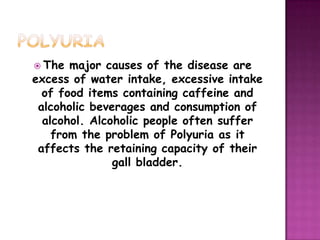Hypocalcemia and Polyuria
- 1. HYPOCALCEMIAHypocalcemia varies from an asymptomatic biochemical abnormality to a life-threatening disorder, depending on the duration, severity, and rapidity of development. Hypocalcemia is caused by loss of calcium from or insufficient entry of calcium into the circulation.
- 2. HYPOCALCEMIACauses of HypocalcemiaDecreased Entry of Calcium Into the Circulation Increased Loss of Calcium From the Circulation Other Causes Hypoparathyroidism (absence of PTH secretion) Postoperative
- 3. Autoimmune (isolated or part of polyglandular autoimmune syndrome)
- 4. Congenital (mutations of CaSR, PTH, and parathyroid aplasia)
- 5. Pseudohypoparathyroidism, types 1a, 1b and 2HYPOCALCEMIAMagnesium depletionSevere hypermagnesemiaDeficiency of vitamin DHyperphosphatemia Renal failureRhabdomyolysisTumor lysisPhosphate administration
- 6. HYPOCALCEMIAAcute pancreatitisHungry bone syndromeChelation CitrateEDTALactateFoscarnetWidespread osteoblastic metastases Prostate cancerBreast cancerSepsis
- 7. HYPOCALCEMIAClinical Manifestations of Hypocalcemia Neuropsychiatric Symptoms Seizures (all types) Dementia (in adults), mental retardation (in children) Emotional problems (anxiety, depression) Extrapyramidal symptoms (parkinsonism is most common) Calcifications of basal ganglia (in longstanding disease) Papilledema
- 8. HYPOCALCEMIAChronic hypocalcemia (hypoparathyroidism) is treated by oral calcium administration and, if this is insufficient, vitamin D supplementation. The serum calcium level should be targeted to about 8.0 mg/dL. Most patients will be entirely asymptomatic at this level, and further elevation will lead to hypercalciuria because of the lack of PTH effect on the renal tubules. Chronic hypercalciuria carries the risks of nephrocalcinosis, nephrolithiasis, and renal impairment
- 9. POLYURIAPolyuria is a medical condition, mostly in adults that causes a frequent urge to urinate repeatedly. Generally, if an adult passes more than 2.5 L over 24 hours then the medical condition of Polyuria is developed. The disease is often seen in conjunction with the medical disorder of increased thirst or polydipsia.
- 10. POLYURIAFirstly, a medical condition of increased thirst is developed in the affected person, which develops an urge to drink water at very short intervals of time. As the water quantity inside the body increases, the body passes the water as urine as soon as the bladder is full.
- 11. POLYURIAThe major causes of the disease are excess of water intake, excessive intake of food items containing caffeine and alcoholic beverages and consumption of alcohol. Alcoholic people often suffer from the problem of Polyuria as it affects the retaining capacity of their gall bladder.
- 12. POLYURIAHigh doses of Vitamin B2 and excessive intake of Vitamin C also results in the problem of Polyuria. Migraine and diabetes is another major affecting problem in the adults. Most commonly, the people entering their thirties and suffering from stress related issues suffer from this problem










